Executive Summary
This document gives the Requirements Specification for an ERP System on an Operating System Platform for the company FedEx. It is proposed that the Supply Chain Management module of the ERP system should be first implemented along with Finance. Later HR and CRM modules can also be plugged in. The document provides a high level discussion of the existing and proposed ERP solution for different branches and divisions of the company. Following figure gives the home page screen shot of FedEx.
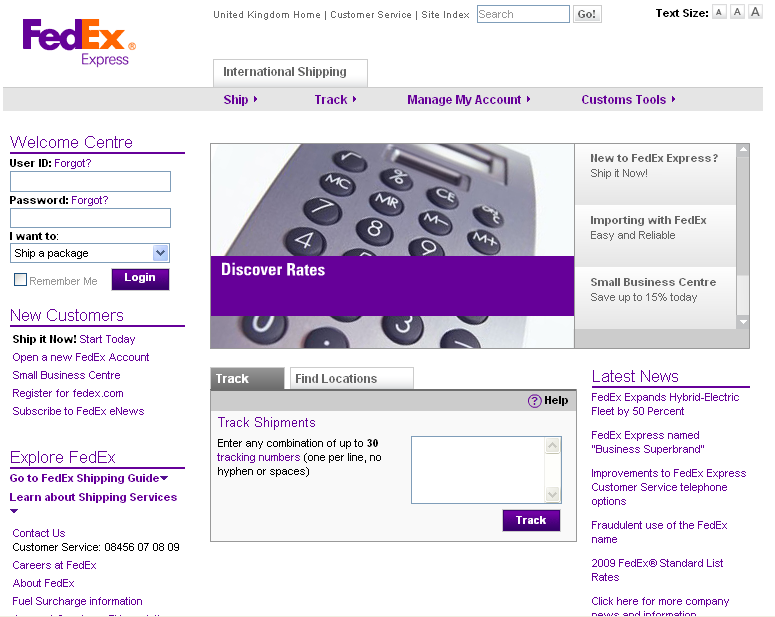
The paper has provided the objectives and purpose of the proposed system along with a rationale of the task. The chapter on proposed requirement specification gives brief information about FedEx along with the feasibility, organisation size and business processes. Details of the proposed solution are given along with the workflow of the interactions; SAP architecture and Homogeneous and Heterogeneous platforms. The important step of sizing and estimation is also explained by using sample studies. Details such as the business functions, degree of complexity and project milestone are also presented.
Ojectives and Purpose of the Proposed system
The proposed system built on the SAP R/3 enterprise resource planning application is designed to connect and integrate all users, logistics department, fleet personnel and operators, finance people, warehouse and routing and other departments. In addition to client server terminals at various locations, it is also proposed to provide mobile network connectivity through hand held devices. There are two aspects for providing access, one for employees of FedEx and other who are customers of FedEx. Employees with the correct authentication can dial up the data centres and despatch centres and relay information about the packages that they are collecting.
The information is relayed automatically to the warehouses and collection centres and so they know consignment is coming, its destination, weight, logistic required and so on. Customers would not have access to this internal network, but they would be given a docket number of their consignment and be able to trace the location of their goods by login in to the FedEx website. This paper would essentially cover the SCM module for internal employees (Fose, 2009).
Rationale of Task
The new system that is proposed would increase the productivity of the organisation and help in increasing communication between employees. The system would also help FedEx to maintain better control over the logistics operations. The requirements specifications document is important as it provides an overview of the proposed solution and gives an approximate idea of the efforts estimation and sizing.
Proposed Requirements specification
About Federal Express
FedEx is one of the largest logistics companies with operations across the world. It operates hundreds of trucks, cargo vans and even has a fleet of aircrafts for overnight delivery across many nations of the world (FedEx, 12 August 2009).
Feasibility
FedEx is a global logistics company and has implemented some very good logistics and supply chain solutions across different cities and units. The whole firm is integrated into a network that is served by the organisation wide LAN and through web services. The feasibility of the study has a higher degree of acceptance since the firm is a steady user of IT systems (FedEx, 12 August 2009).
Size of Organisation
FedEx has a number of subsidiaries such as FedEx Freight, FedEx Supply Chain and others and the firm as 280,000 employees. It provides delivery either directly or through its subsidiaries. The company had a turnover of 37.95 billion USD in 2008 (FedEx, 12 August 2009)
Business Processes
There are a number of business processes that would be covered by the ERP solution. The logistics and supply chain process and interactions are key to the organisational performance and these would be covered. Other important areas are finance and account; customer relation management and also the HR functions (FedEx, 12 August 2009).
Proposed Landscape
This section gives details of the proposed landscape. Included are the workflow of the proposed system, network configuration and SAP architecture and other details.
Workflow for the Proposed System
The proposed workflow system is illustrated in the following figure
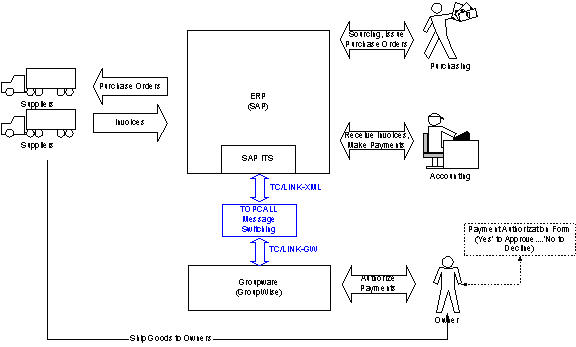
- Enhanced customer service: With ERP systems, it is possible to increase customer response fill rates to about 98%. This would mean that customer requirements would be met more often, as and when needed (Ho, 2004).
- Better cash flow: Since finance and accounts systems are integrated along with other departments, it is possible to source material and ensure payment as per the payment terms regularly. With ERP in place, cash on hand, receivables, payables, outstanding amount and other financial details can be reconciled easily and organizations would procure only items that are needed (Huth, 2000).
- Better planning: ERP helps to forecast demand for products and create a schedule where marketing could tell with more accuracy which products are needed and when. Since the raw material required for each component are fixed, it is possible to calculate the total common components that are required and create a schedule for the delivery. This would be again matched with stock in hand and only shortfall material can be ordered thus reducing the capital blocked in inventory (Infosys, 2009).
- Strategic planning: With accurate information available to the management, it can take up planning to understand problems in different departments of the organization. Once the problems are identified, it is possible to segregate the bottleneck areas, technology gaps, and manpower problems and increase productivity and make the organization more efficient (Kim, 2005).
- Vendor management: ERP allows vendors to be rated as per the quality and timeliness of deliveries. Once vendor performance is quantified as per metrics, tiers for vendor ranking can be initiated and reduce the number of vendors to the few that show good performance (Loh, 2004).
- Task automation: ERP helps to automate routine tasks and with barcode readers installed in the organizations, tasks such as entering details when stock is brought in or taken out of stores, billing, voucher generation, cheque or online transfer of payments and a number of other tasks can be automated. This helps to reduce errors that can arise during manual entry and reduce manpower requirements (Loh, 2004).
- Manpower planning: HRM can make good use of the HR module that allows payment of wages, based on inputs such as attendance card swiping, production figures, overtime, holidays and leave and so on. HRM can also enter employee appraisal details into the system and make promotions, reduce errors of wage calculation during annual salary hike and so on (Infosys, 2009).
- Logistics: With known schedule of manufacturing, it would be possible to know when exactly goods would be manufactured and when they would be ready for dispatch. Based on this data, logistics can plan shipment to different destinations and ensure that the trucks spend the least time waiting for material (SAP WebAS, 2008).
Network Configuration and SAP Architecture
SAP Web Application Server is used for implementing the server and client based solutions. Server applications such as portals and online shops can be created in an external tool or in the integrated development environment. These contain html pages as well as web pages along with dynamic script code. The server can be used to run ABAP as well as Java programs. The server forms the application platform for the NetWeaver application of SAP. Please refer to the following figure.
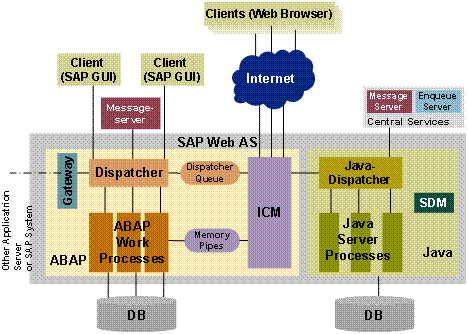
As seen in the above figure, there are a number if interlinked components that make up the SAP server. The ICM – Internet Communication Manager connects to the Internet. It is used to process the client web request and also the server components and it supports protocols such as SMTP, HTTPS and HTTP. The server can play the role of a web server and the web client. The dispatcher is used to distribute the requests to the appropriate work processes and all the processes are engaged, then the requests are queued in the dispatcher queue.
ABAP code of the application is executed by the ABAP work process and the SAP Gateway is used to initiate the RFC interface between the SAP instances in the SAP system and also beyond the system boundaries. The message server is used to exchange messages and also to perform load balancing actions in the SAP system. The java component there are three sub components, software development manager, server process and the java dispatcher (SAP WebAS, 2008).
Homogeneous and Heterogeneous platform
The following figure shows the mix of the homogenous and heterogeneous platforms and modules that would be connected to the system. As seen in the above figure, a number of tools and packages that are sold by different vendors, along with a number of sub systems processes are integrated to form the EAS services. Also included as a number of other applications such as business intelligence tools, web interfaces, content delivery systems and many others. Companies such as SAP do not make most of the other applications but when such applications are integrated into the system, they offer a unique competitive advantage. In addition, tools such as BPM are also integrated and a graphical user interface is provided that allows easy interactions.
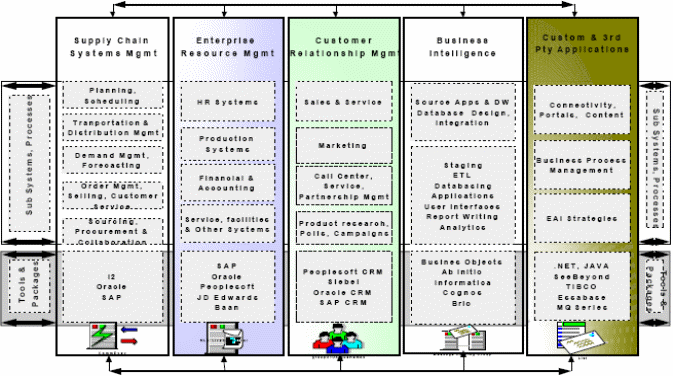
Assumptions
The paper has been written based on a certain number of assumptions. This section provides a list of the assumptions made.
Business functions
Bishop (2000) recommends that a survey with a set of questions should be administered to the users of the system. The survey is designed by the hardware vendor, to extract the details of the business that are critical to estimating hardware and software resources. This information is needed to establish end user response time goals and related performance characteristics. Information about specific performance expectations is gathered such as order entry transactions must average less than two seconds, estimates of how many people will need access to the system, the number and type of transactions to be executed, and anticipated growth for the next few months or years
Table 4.1. Sample of a Survey’s User Information (Bishop, 2000).
Degree of complexity
Bishop (2000) The Transaction Counts provides the basic input needed for accurate sizing of workloads by module. The first request for information in the following sample Transaction Counts figure. It shows the online and batch activity. With SAP’s R/3, System, one can segregate batch workload so that online users are virtually unaffected by batch/background activity. Another complexity is to estimate resources to handle periods of heavy activity, or peaks.
Vendors will combine the peak processes from each module with production schedules from other sections in the survey and determine how to configure a system that best balances the hardware costs for an “oversized” system built to handle the flashes of peak demand, with the slow performance costs from an “undersized” system built to handle the extended periods of normal activity (Bishop, 2000).
Table 4.2. Sample of a Survey’s Transaction Counts (Bishop, 2000).
Project milestones
ERP applications are very huge and complex and even though the basic applications are off the shelf products, there has to be a number of phases involved before the product can be used and the implementation called successful. The timeline for a typical ERP implementation is shown in the following figure.
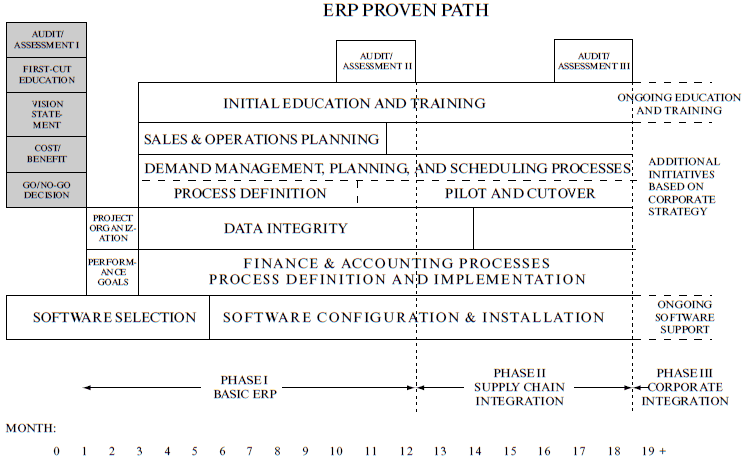
Because of the complexity involved in ERP projects, in house expertise has to be often augmented by hiring external experts and consultants. The duration for the full implementation cycle would vary depending on the complexity of the project. A small project would take between 3 to 9 months while larger complex projects would take more than two years. Given the high employee turnover in the IT industry, the organization should prepare itself for the inevitable employee turnover.
There should be extensive documentation along with knowledge transfer and handover procedures. This would help the organization to continue the project even when key personnel leave. Organizations may take the help of ERP vendors and even consulting companies who would provide services such as customisation, consultation and support. In addition, there would be business analysts, program managers, change management specialists and data migration specialists.
Based on the article by Bishop (2000), the following Gantt chart of the steps and activities and the duration required for the ERP development is given
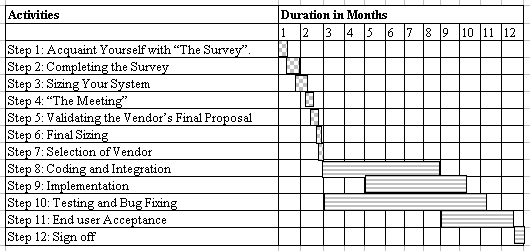
Conclusions
The paper has presented the requirement analysis for a SAP implementation for FedEx company. The objectives were to frame the requirement specification document for the SAP implementation. A SAP architecture has been proposed that would help to solve the problems that the firm iis facing. The workflow for the proposed system has examined the interactions between the different stakeholders of the firm. The network configuration and SAP architecture has been discussed along with the sizing of the firm for effort estimation. A Gantt chart of the implementation has been provided to illustrate the time line for implementation.
References
Bishop, Kurt. 2000. Size Does Matter — Strategies for Successful SAP R/3 Capacity Planning. Wellesley Information Services.
FedEx, 2009. FedEx Extends Access to Shipping Services for Increased Customer Productivity and Loyalty. Web.
Fose, F., Hagemann, S. and Will, L. 2009. SAP NetWeaver AS ABAP System Administration, SAP Press, New York.
Hagemann, S and Will, L. 2003. SAP R/3 System Administration, SAP Press, New York.
Ho Chin Fu, Wu Web Hsiung, 2004. Strategies for the adaptation of ERP systems. Industrial Management and Data Systems, 104(3), pp. 234-251.
Huth S. , Kolburger R., Meyer Hans-Martin, 2000. SAP R/3 7 Windows NT. Addison Wesley.
Infosys, 2009. Business Process Management – Enterprise Application Integration. Web.
Kim Yongbeom, 2005. Impediments to successful ERP implementation process. Business Process Management Journal, 11(2), pp. 158-170.
Loh Tee Chiat, Lenny Koh Siau Ching, 2004. Critical elements for a successful ERP implementation in SMEs. International Journal of Production Research, 42(17), pp. 3433–3455.
SAP WebAS, 2008. Architecture of the SAP Web AS. Web.
Tomb Greg, 2006. Implementing ERP: Lessons learned from the front. SAP Insight. Web.
